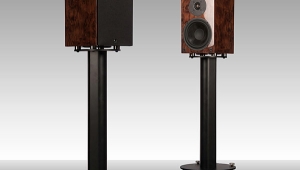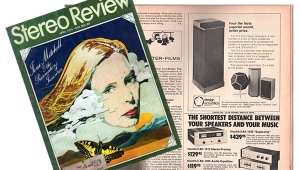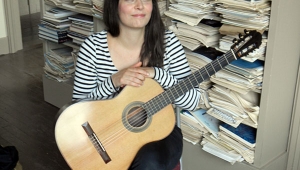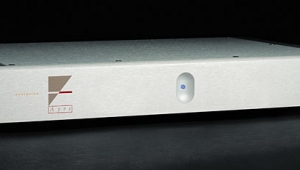| Columns Retired Columns & Blogs |
The Fifth Element #66 Page 3
The Sonab had four leaf tweeters arranged in a square pointing up at about 45° from the top of a rectangular woofer enclosure. I heard a pair ca 1976 and was thoroughly gobsmacked—their sound was so much more dimensional, vivid, and tactile than from the Klipschorns the dealer had in the same room. (Of course, it's possible that the dealer had intentionally set up the K-horns poorly.)
Shahinian's Arc, still in production at $5500/pair, looks quite similar to the Silent Speaker II, except that it's much more complicated. The Arc is a three-way design with the woofer, midrange, and tweeter all on the canted top panel, and a passive bass radiator on the rear, at the end of a transmission line. I heard the Arcs more than a decade ago, when I was writing for The Abso!ute Sound, and was very impressed by their natural timbre, superwide soundstaging, and their bass and dynamics—when driven by an amplifier with adequate current and damping factor.
Epicure's Model 20, of course, is a direct ancestor of the Silent Speaker II, with a nearly identical cabinet shape. (If I ever heard the Model 20, I don't recall it, but I certainly recall the post-Burhoe EPI 3.0—the first great loudspeaker I heard that was tantalizingly just beyond my financial reach.) Epicure's "secret sauce" was to create different loudspeakers out of combinations of a basic module Burhoe designed, which consisted of one 8" woofer and one 1" tweeter and the necessary crossover components. The Model 20 had comprised two of these modules, and therefore was somewhat bulkier than the Silent Speaker II.
 In conversations, Burhoe told me that his design goals for the Silent Speaker II were: as extended and even a frequency response as possible; wide dispersion; a vent designed to be free of noise and resonances; and the prevention of standing waves inside the enclosure. It was for the sake of wider dispersion that he went from his previous 8" woofer designs to a 6.5" woofer. The woofer loading is designed somewhat in the manner of horn loading, and that apparently is where Burhoe concentrated much of his development work. I surmise that the cabinet's interior is more complicated than in other speakers costing under $1000/pair, not only from the remarkable bass performance but also because the recess for the binding posts is more than halfway up the rear panel instead of at the lower edge, where you might expect it. The latter suggests to me that there is an internal structure, whether braces or a waveguide, that requires that placement.
In conversations, Burhoe told me that his design goals for the Silent Speaker II were: as extended and even a frequency response as possible; wide dispersion; a vent designed to be free of noise and resonances; and the prevention of standing waves inside the enclosure. It was for the sake of wider dispersion that he went from his previous 8" woofer designs to a 6.5" woofer. The woofer loading is designed somewhat in the manner of horn loading, and that apparently is where Burhoe concentrated much of his development work. I surmise that the cabinet's interior is more complicated than in other speakers costing under $1000/pair, not only from the remarkable bass performance but also because the recess for the binding posts is more than halfway up the rear panel instead of at the lower edge, where you might expect it. The latter suggests to me that there is an internal structure, whether braces or a waveguide, that requires that placement.
Although I had been aware of Direct Acoustics for at least a year and probably two, had bookmarked its website, and had it in mind to eventually get in touch, what prompted me to take action was a conversation I had late last year, at Parsons Audio's annual trade fair, with the recording engineer and musician Micha Shattner. Micha has some of the best ears I have ever seen at work, and he does not gush praise as a standard operating procedure. Indeed, he did not gush at all over the Silent Speaker II; he simply said that, at the price, there was nothing like it. He also said that, owing to the Silent's cabinet shape and driver disposition, one could position a second pair back to back with the first pair's left and right speakers, thus gaining a more efficient coupling to the room, and dispersion performance that would be closer to the omnidirectional ideal.
One final point before I get to my listening impressions: On Direct Acoustics' website, Burhoe claims that stereo imaging is often pursued at the expense of timbral accuracy, and that he is more concerned with accurate reproduction of sound than of stereo imaging. I don't have a problem with this because, at the end of the day, my evaluation of a component comes down to two metrics: does the component allow or cause me to have an emotional response to the music? and how am I going to feel when I pack these things up and ship them back?
In a Non-Silent Way: The Silent Speaker II is not a loudspeaker you can connect anything to and get great sound—it took me a while to get out of them a sound I really liked. In fact, when I hooked them up to Luxman's excellent D-05 SACD/CD player ($5000), CL-88 tube preamp ($6000), and MQ-88 tube power amp ($8000), wired with about $10,000 worth of Cardas Clear cables, the Direct Acoustics didn't sound great at all. I think there was too much top end going in through the Cardas Clears, and the tube amp didn't do an adequate job of controlling the bottom end. Switching over to ">Ayre Acoustics' AX-7e integrated amplifier and ">CX-7e CD player ($3500 each), using Ayre's own balanced interconnect cables but Nordost's new Flat 2 speaker cables ($152.49/2.5m pair with banana terminations?), gave me the best sound I was able to get. More to the point, that sound was beyond respectable—it was exciting, and it elicited from me real emotional responses.
The only fly in the ointment was that this great, eminently listenable, can't-complain-about-anything-without-sounding-like-an-ungrateful-jerk sound was the product of electronics that cost more than 10 times the speakers' price. The Silent Speaker IIs' performance with the more class-appropriate TEAC and Marantz CD receivers (full coverage in a future issue), although fine, was just not as textured or engaging or blemish-free, the biggest blemish being that the budget CD receivers' amplifier sections simply could not exercise the control over the Silents' apparently complex bass loading that the much more expensive Ayre integrated did. So most of my comments are directed toward the best-case scenario (for the speakers) of using $7000 worth of Ayre electronics with a $748 pair of speakers. After experimentation, I set up the Silent Speaker II 3' from the sidewalls, 4' from the front wall, 5' apart, and toed in directly to face the listening chair. My intention in setup was to minimize bass reinforcement from room boundaries.
The Silent Speaker II had a "traditional New England" warm tonal balance. I think that says an awful lot of everything that can be said, right there. For the most part, its errors are of omission rather than commission. Properly set up with synergistic equipment, the SSII was as listenable as all get-out. I think that two important factors were my use of Nordost's affordable copper speaker cable, and the simple expedient of following the designer's wishes and using the speakers with their grilles in place. I have never heard a loudspeaker before where the grilles made such a positive difference, or where their absence made the loudspeaker appreciably less listenable.
For the money, this speaker went crazy deep. For John Atkinson, I played through the Vivid B-1s a brief level-setting sound check for a pipe-organ recording session. The Silent Speaker IIs went at least as low as the Vivids, and were even a touch louder in the bass (which may be attributable to "port bass" or room reinforcement), but were nowhere near as focused. I can't speak for Direct Acoustics' claimed frequency responses, but I can say that, in my room, the Silents played a 32Hz low C at what sounded like full volume to me, and I'm the one who made that recording.
A relative lack of pinpoint stereo imaging is not always a bad thing. I've always had a problem with Bill Evans's Village Vanguard sessions: his piano is in the right channel, and the bass and drums are in the left channel. It's really a dual-mono recording with nothing going on in the middle. Through the Silent Speaker IIs, those recordings sounded more as if the musicians were playing (and the drinkers tinkling their glasses) live in the room than they do through speakers that image more conventionally.
Within the ambit of its warm tonal balance, the SSII did a very good job—for its price, and given its designer's ambition that it be full-range—of integrating the outputs of its tweeter and woofer. Richard Lehnert's speaking voice in the "Channel Phasing" track on Test CD 2 (Stereophile STPH004-2) exhibited a touch of "cupped-hands" coloration, but that didn't noticeably affect most music; apart from the test CD, it showed up only in Andrea Bocelli and Thomas Hampson's performance of the duet from Bizet's Les Pêcheurs de perles, which can sound a bit hooty through any speakers.
On at least a few occasions with the class-appropriate CD receivers, and quite a bit more reliably with the Ayre electronics, the Silent Speaker IIs became things I listened to for the pleasure of hearing music, rather than out of a sense of obligation. Standout tracks included Johnny Hartman's album with John Coltrane, Eliahu Inbal's Mahler Fifth on Denon, opera excerpts from tenors Brian Cheney and Ben Heppner, string quartets of Ravel and Debussy by Quartetto Nuovo, and Dagmar Pecova's luminous recording of Wagner's Wesendonck Lieder on Supraphon. Even with the CD receivers, the sound was at least as engaging as that of any speaker I auditioned two years ago—with the proviso that some, such as ">Aerial's 5B, bit off less and therefore could chew more thoroughly. Winslow Burhoe has obviously put his half-century of experience to good use.
Summing Up the Direct Acoustics Silent Speaker II
Pros: For the price: amazing bass; reasonably coherent from deep bass to upper treble; careful attention to setup will minimize colorations.
Cons: Dated looks; utilitarian design and ordinary fit'n'finish; will probably only rarely be partnered with electronics that show how good they are.
Verdict: I could live with these speakers. Strong contenders for Budget Product of the Year.
- Log in or register to post comments




































